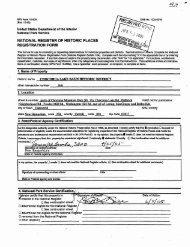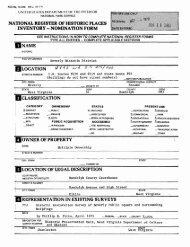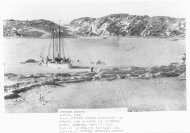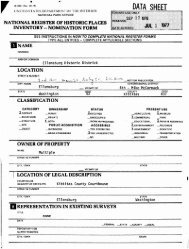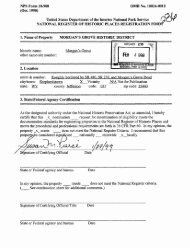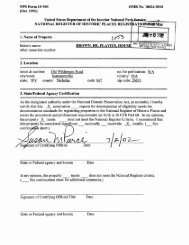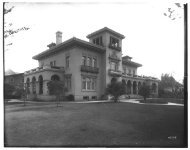National Register of Historic Places Registration Form
National Register of Historic Places Registration Form
National Register of Historic Places Registration Form
Create successful ePaper yourself
Turn your PDF publications into a flip-book with our unique Google optimized e-Paper software.
NPS <strong>Form</strong> 10-900-a OM8 Approval No. 10244018<br />
(8-88)<br />
United States Department <strong>of</strong> the Interior<br />
<strong>National</strong> Park Service<br />
<strong>National</strong> <strong>Register</strong> <strong>of</strong> <strong>Historic</strong> <strong>Places</strong><br />
Continuation Sheet<br />
CLEVELAND PARK HISTORIC DISTRICT<br />
WASHINGTON D.C.<br />
Section number 8 Page n<br />
great that the other subdivisions dropped their<br />
original names and sought to be identified with<br />
Cleveland Park. This is how the original Cleveland<br />
Park <strong>of</strong> 1894 expanded from Newark, Macomb and<br />
Highland to the larger boundaries which are identified<br />
as Cleveland Park today and which are proposed for the<br />
historic district. In Cleveland Park Voices former<br />
and present residents <strong>of</strong> Cleveland Park repeatedly<br />
agree that the neighborhood includes residents from<br />
Woodley to the Kelvin Hazen Park.<br />
3. In the area <strong>of</strong> apartment house development Cleveland Park has two<br />
distinctions. The first garden apartments in the city, known as the Cleveland<br />
Park, were constructed in 1924-25 at 3018 - 3028 Porter Street. Secondly,<br />
Cleveland Park is the location for some <strong>of</strong> the earliest and most innovative<br />
suburban apartment houses built in the city; most notable are Tilden Gardens<br />
(1928-30) and the Broadmoor (1928). James Goode has called "Tilden Gardens the<br />
most innovative apartment house built in Washington during the 1920's." It is<br />
significant because <strong>of</strong> "its unique landscaping plan (which covered 3 <strong>of</strong> the 5<br />
acres <strong>of</strong> land with extensive designed gardens) and because it remained the<br />
city's largest luxury apartment house built as a co-op until the Watergate was<br />
constructed in the 1960's" >v (James Goode; first draft: Best Addresses, A<br />
Century <strong>of</strong> Washington's Distinguished Apartment Houses, 1880-1980; to be<br />
published in 1987 by the Smithsonian Institution Press.)<br />
A. Harry Wardman constructed the first apartment house<br />
in Cleveland Park at 3520 Connecticut Avenue in 1919.<br />
He followed this with ten rowhouses (3500-3518<br />
Connecticut) in 1921. He unified the rowhouses in an<br />
overall scheme drawn from the five-part Colonial<br />
Georgian houses <strong>of</strong> the 18th-century. Apartment houses<br />
predated the shops on Connecticut and in fact provided<br />
the location for the first shop which opened in the<br />
ground floor <strong>of</strong> the Monterey apartment house in 1923.<br />
B. The Cleveland Park, Tilden Gardens and the<br />
Broadmoor exemplify the historical eclecticism <strong>of</strong> the<br />
period which drew upon the building shapes and<br />
decorative elements deriving from Tudor and Jacobean<br />
architecture <strong>of</strong> the 16th- and 17th-centuries in England.<br />
C. Subsequently, the Art Deco Style became the fashion<br />
and was used by Mihran Mesrobian in the Sedgewick<br />
Gardens <strong>of</strong> 1931 and the Macklin <strong>of</strong> 1939. Consequently,<br />
Cleveland Park features significant stylistic examples<br />
showing the evolution <strong>of</strong> apartment house design.



